Stone is a ubiquitous traditional material, first used in prehistory to create tools and sacred objects, and then to create the impressive buildings, monuments and statuary that surround us. Nature has provided what seems like an endless abundance of stone types, with variations in color, texture and working properties. Stone is most often worked by direct carving or cutting with a variety of tools; surfaces are polished, honed or painted.
Stone is a naturally occurring aggregate of minerals varying in hardness and workability. Condition issues affecting stone objects often relate to their environment. For example, outdoor monuments have suffered greatly from pollution, particularly from acid rain and sulfur crusts. Other typical issues include soluble salts, cracking, spalling, surface erosion and biological attack.
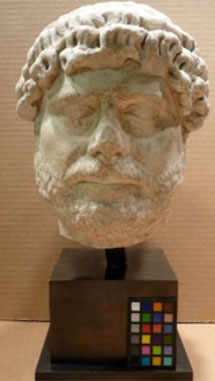
Egyptian Limestone Relief
This particular Egyptian limestone relief dates to the Ptolomeic Period. Its image, depicting the God Harpocrate, the son of Osiris, is carved in low relief and has original paint remains still intact.
The relief was suffering from soluble salts, unstable pigment and aged restorations. Analysis of an unstable surface coating was carried out to determine if it was original to the piece or a later addition. The material was found to be a restoration paint and was removed. Old, discolored fills as well as an old repair to the reverse were also removed. New fills made from easily reversible materials were introduced and visually integrated to match the surrounding areas.
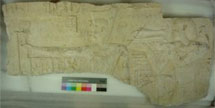
Ptolomeic Carving Before Treatment
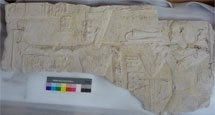
Ptolomeic Carving After Treatment
Khmer Sandstone Figure
This sculpture, about 3 feet in height, arrived at our studio with significant oily surface soiling and staining, and a coarse fill material applied in some areas of loss. After numerous tests to determine the most efficient cleaning technique that would reduce soiling without causing damage or change to the stone surface, the entire sculpture was cleaned with a poultice that could be applied wet and dried to an elastic film. Once removed, many of the stains were significantly reduced and the original surface coloration of the stone was more visible. The old fill material was reduced and new, stable fills were applied and toned to better integrate with the surrounding stone.
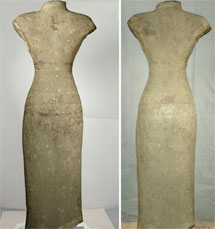
Khmer Sandstone Figure Before and After Treatment
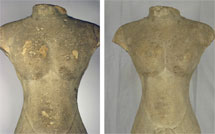
Khmer Sandstone Figure Detail Before and After Treatment



